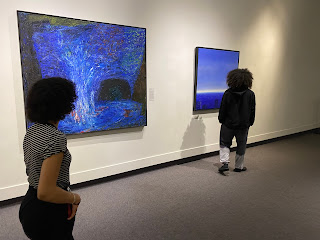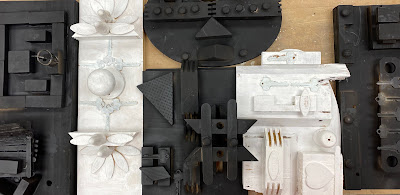Saturday, December 3, 2022
Cardboard Gingerbread Houses & Paper Snowflakes
Festival of Trees
Clay Bell Ornaments

Tactile Ornaments
It's easy to make tactile Christmas tree ornaments with young children with dried beans and pasta. My elementary school art students with visual impairments loved making something tactile that they can hang on their family tree. I offered them a piece of mat board cut in the shape of their choice, and then it was a matter of them choosing from bowls of dried foods to glue into place. Some made turtles from pecan shells and beans, others made flowers from pasta shells, but they each ended up with something they could feel and remember for years to come. These can be spray painted silver or gold, or left with the natural colors contrasting with the board. Make the next snow day a craft day and try this simple ornament idea with your kiddos!
Monday, November 28, 2022
Cross Contour Portraits
Turkey Crafts
Friday, November 11, 2022
Autumn Tree Tissue Paper Collage
Fauve Faces
I encouraged students to work large for their Matisse style portrait assignment. They were to use the correct proportions for drawing a face as the starting point, and then try to find a way to use color in an unexpected way. Faces were divided into areas of greens, oranges, purples and yellows. Most of the time it was two main colors on the face, and then the shirt, hair and background were to use contrasting primary or secondary colors.
Printmaking and Leaves

Saturday, November 5, 2022
Modifying Portrait Lesson for the Blind
Tactile Doodle and Wiki Stix make it possible for my students with no vision to do the same portrait assignment as my students with low vision. For this project students take an oval, draw the line of symmetry, and divide it into fractions to make sure the face is proportional. Some students have enough vision to see up close or with magnification devices, but for those who need the art to be tactile, Wiki Stix are the easiest thing to find. The downside is that they don't always stay on the paper permanently, and they may need to be cut into smaller pieces for smaller features. The Tactile Doodle is perfect for students with sensory issues and you can draw small lines with immediate results. The drawback is that you can't color or paint on the plastic sheet that you need to make the raised lines, and the sheets are expensive.
Wednesday, November 2, 2022
Monster Mash Project
Shape, Color, Size are all design elements to consider when creating a monster collage. Elementary and Middle School students were able to use their imaginations to come up with their own original monster.
Wednesday, October 19, 2022
Alumni Achievement Award
When Brigham Young University told me I was going to receive the College of Fine Arts and Communication's Alumni Achievement Award, I wondered how they found out about the twenty pounds I lost during COVID quarantine. If that wasn't my greatest achievement, I don't know what was. I didn't ask questions, I just showed up and let them pamper me.
 |
| photo by Scott Young |
 |
| Photo by Scott Young |
APH Insights Art Contest Field Trip
After two COVID years and an online ceremony, it was so great to finally get to take my students to Kentucky for an in-person APH Insights Art Contest exhibit and awards banquet.
 It's a thrill for me to take students who have never flown before on a plane. We definitely got our share of ECC (Expanded Core Curriculum) practice. Students with visual impairments are required to learn skills to navigate life, on top of the normal school curriculum. Orientation and Mobility, for example is an important skill that we used a lot: using elevators, escalators, moving sidewalks, buses, Uber cars, planes, airport trains-we did it all! And don't forget the experience eating a fancy meal and knowing which of the 3 forks, two knives, to use first.
It's a thrill for me to take students who have never flown before on a plane. We definitely got our share of ECC (Expanded Core Curriculum) practice. Students with visual impairments are required to learn skills to navigate life, on top of the normal school curriculum. Orientation and Mobility, for example is an important skill that we used a lot: using elevators, escalators, moving sidewalks, buses, Uber cars, planes, airport trains-we did it all! And don't forget the experience eating a fancy meal and knowing which of the 3 forks, two knives, to use first. While we were in Louisville we took advantage of the Jacko-o-Lantern Spectacular! All four of my kids were low vision, rather than totally blind, so they could appreciate the lights, and they loved the sounds and music throughout.
While we were in Louisville we took advantage of the Jacko-o-Lantern Spectacular! All four of my kids were low vision, rather than totally blind, so they could appreciate the lights, and they loved the sounds and music throughout.It was a fantastic trip and will inspire other students to work hard and try to submit top-notch art pieces to be able to attend in the future.
Wednesday, September 28, 2022
My Journey In Art Exhibition
The ten minute drive made for a quick field trip, but I think our students were happy to experience a wide range of displays and a personal tour by our very own French teacher.















































